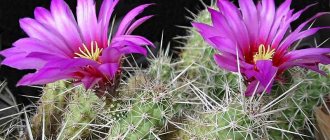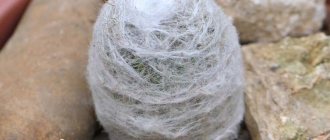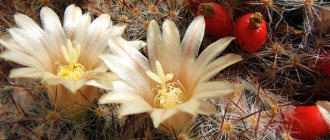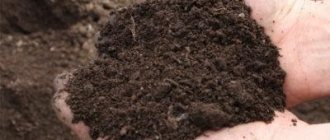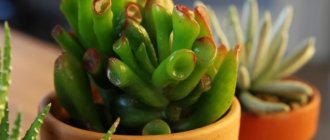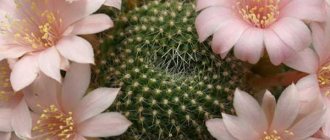general description
The trunk has a round, ribbed exterior . Since there is a similarity to a ball, the evaporation of moisture from the surface in this case is very small. And during the wet period, the ribs swell, helping the owner to absorb as much water as possible without cracking or bursting. Succulents are accustomed to living in poor, dry soil, and overwatering is extremely dangerous for them .
Flowering also depends on the amount of moisture; for desert dwellers this will not happen if the rains were not heavy or started late.
To protect from the sun, some have very thick skin , others spread out greatly to create shade for the main stem. There are also species that appear fluffy due to the large number of spines or hairs that completely cover the plant; there are no leaves .
Tropical (forest) cacti
Tropical cacti are more warm and moisture-loving; they grow in diffused light in the special conditions of the humid evergreen forests of South America. Almost all representatives of forest cacti are epiphytes (grow on other plants), have long hanging stems, thin, soft, sometimes almost invisible, needles.
IN THE PHOTO: Schlumberger (or “Decembrist”)
A characteristic feature of epiphytic cacti is the ability to form aerial roots on the stems. Such roots serve to capture moisture from the air and attach to the bark of trees.
There are several groups of domestic tropical cacti:
- Whisker cacti with winter watering (cacti of the genus Heliocereus).
- Whisker cacti with a winter dormant period (Aporocactus, Hylocereus and Selenicereus).
- Leaf cacti blooming in spring and summer (Hatiora, Lepismium, Epiphyllum).
- Leaf cacti that bloom in autumn and winter (Schlumbergera and Rhipsalium).
Caring for Tropical Cacti
When growing tropical cacti, it is necessary to take into account some features that distinguish them from desert species - Otherwise, the principles of caring for desert and tropical species are the same:
- Tropical species grow in conditions of higher humidity and require frequent watering during the growth period without waterlogging the soil; such cacti can be frequently sprayed. Water only with warm water, settled or purified from impurities.
- The soil is selected with an acidic reaction, poor in organic matter. The soil must be loose and permeable to moisture.
- Cacti of the tropics are fed during the growing season. Only special mixtures intended for this group of plants are used.
- Replant plants as needed. To ensure tropical cacti bloom well, they are planted in small containers. The root collar is not buried; it is better to refrain from watering for several days after transplantation.
- Some whip cacti require a winter dormant period; at this time, reduce the temperature and stop watering. Plants that bloom in the autumn-winter period are dormant in late summer - early autumn. Certain species (genus Heliocereus) require watering in winter.
- Tropical cacti grow well only in diffused light; they do not tolerate direct sunlight. Some types of "leaf cacti" require partial shade.
- Forest cacti are quite thermophilic; the temperature should be above +12°C even in winter.
- The shoots of tropical cacti grow greatly; they need to be thinned out, removing old, damaged or improperly growing ones. Pruning is done in spring or early summer.
Photo
We bring to your attention photos of desert cacti:
A few final tips
- Cacti do not like sudden changes in conditions; plants are accustomed to any changes in the regime gradually. Some cacti react negatively even to moving the pot to another location.
- The most common cause of death of cacti is rotting of roots and shoots; to avoid this, you should follow the rules of watering and replanting plants.
- When caring for cacti, you need to focus on the type of specific plant and the natural conditions of its growth.
- Most cacti require a period of rest, when the plant does not need to be watered or fed, but should be kept at a low temperature.
- Almost all cacti bloom better in a cramped pot; too much soil has a negative effect on the development of the plant.
- If buds appear on the cactus, the plant cannot be rearranged, rotated, changed the frequency of watering, fed or replanted. Otherwise, the buds will be dropped or turn into vegetative shoots.
Reviews
Poster House of Corleone Cactus in the desert 07-0323-21x30, 21x30 cm and other products in this category are available in the catalog of the Leroy Merlin online store in Moscow at low prices. Read the detailed characteristics and description, as well as reviews of this product, to make the right choice and order the product online.
Buy products such as Poster House Corleone Cactus in the desert 07-0323-21x30, 21x30 cm, in the Leroy Merlin online store, having first checked their availability. You can receive the goods in Moscow in a way convenient for you; to do this, read the information about delivery and pickup.
You can always place an order and pay for it online on the official website of Leroy Merlin in Russia. For residents of the Moscow region, we not only have low prices for products such as “Poster House Corleone Cactus in the desert 07-0323-21x30, 21x30 cm”, but also fast delivery to cities such as Moscow, Balashikha, Podolsk, Khimki, Korolev , Mytishchi, Lyubertsy, Krasnogorsk, Elektrostal, Kolomna, Odintsovo, Domodedovo, Serpukhov, Shchelkovo, Orekhovo-Zuevo, Ramenskoye, Dolgoprudny, Pushkino, Reutov, Sergiev Posad, Voskresensk, Lobnya, Ivanteevka, Dubna, Yegoryevsk, Chekhov, Dmitrov, Vidnoye, Stupino, Pavlovsky Posad, Naro-Fominsk, Fryazino, Lytkarino, Dzerzhinsky, Solnechnogorsk, Istra and Zhukovsky.
Interesting facts about the Sahara
Among the interesting facts about the Sahara, it should be noted that it is not completely deserted. More than 500 species of flora and several hundred species of fauna are found here. The diversity of flora and fauna forms a special ecosystem on the planet.
p, blockquote 53,0,0,0,0 –> p, blockquote 54,0,0,0,1 –>
In the bowels of the earth, beneath the sandy seas of the desert, there are springs of artesian water. One of the interesting phenomena is that the territory of the Sahara is changing all the time. Satellite images show that the desert area is either increasing or decreasing. If the Sahara was previously a savannah, now it is a desert, it is very interesting what several thousand years will do to it and what this ecosystem will turn into.
- Author: Maria Sukhorukikh
Rate this article:
- 5
- 4
- 3
- 2
- 1
(0 votes, average: 0 out of 5)
Share with your friends!
Climatic conditions in the desert
The Sahara has an extra-arid climate, that is, dry and hot tropical, but in the far north it is subtropical. The desert recorded a maximum temperature on the planet of +58 degrees Celsius. As for precipitation, it is absent here for several years, and when it falls, it does not have time to reach the ground. A common phenomenon in the desert is wind that raises dust storms. Wind speed can reach 50 meters per second.
p, blockquote 7,0,0,0,0 –>
There are strong differences in daily temperatures: if during the day the heat is over +30 degrees, which makes it impossible to breathe or move, then at night it becomes cool and the temperature drops to 0. Even the hardest rocks cannot withstand these fluctuations, which crack and turn into sand.
p, blockquote 8,0,0,0,0 –>
In the north of the desert there is the Atlas mountain range, which prevents Mediterranean air masses from entering the Sahara. Moist atmospheric masses from the Gulf of Guinea move from the south. The desert climate affects neighboring climatic zones.
p, blockquote 9,0,0,0,0 –>
Saguaro National Park
Unique giant plants grow only in the Sonoran Desert, which stretches from Arizona to Mexico. The state protects these unusual forests, where dense thorns are visible on the trees instead of leaves.
Since 1933, the desert territory has been a nature protection zone. Even when constructing roads or any structures, they take into account whether the construction will damage the natural attractions of the United States.
In 1994, a National Park appeared, the basis of which is the territory of the Green Desert. This is what Sonora is called. This desert is radically different from other desert areas.
Relief
In fact, sand occupies only a quarter of the Sahara, and the rest of the territory is occupied by stone structures and mountains of volcanic origin. In general, we can distinguish the following objects in the desert:
p, blockquote 46,0,0,0,0 –>
- Western Sahara - plains, mountains and lowlands;
- Ahaggar - highland;
- Tibesti - plateau;
- Tenere – sandy expanses;
- Libyan Desert;
- Air - plateau;
- Talaq – desert;
- Ennedi – plateau;
- Algerian desert;
- Adrar-Iforas - plateau;
- Arabian Desert;
- El Hamra;
- Nubian Desert.
The largest accumulations of sand are in such sandy seas as Igidi and the Great Eastern Erg, Tenenre and Idehan-Marzuk, Shesh and Aubari, the Great Western Erg and Erg Chebbi. There are also dunes and dunes of various shapes. In some places there is the phenomenon of moving and also singing sands.
p, blockquote 47,0,0,0,0 –>
Desert terrain
p, blockquote 48,0,0,0,0 –>
If we talk in more detail about the relief, sands and the origin of the desert, scientists claim that the Sahara was previously an ocean floor. There is even a White Desert here, in which white rocks are the remains of various microorganisms of antiquity, and during excavations paleontologists find skeletons of various animals that lived millions of years ago. Now sands cover some parts of the desert, and their depth in some places reaches 200 meters. Sand is constantly transported by winds, forming new landforms. Under the dunes and sand dunes there are deposits of various rocks and minerals. When people discovered oil and natural gas deposits, they began to extract them here, although it is more difficult than in other places on the planet.
p, blockquote 49,0,0,0,0 –>
Description of desert cacti, their family and names of the main species, photos
In the hot desert under the scorching sun, where it would seem that nothing can survive, cacti stretch upward.
There is no rain in such places for up to several months, and sometimes for more than one year. What saves is the night fog, after which the formed droplets of dew run down along the edges of the stem down to the very roots, feeding them with the necessary moisture.
To ensure that the reserves are sufficient from downpour to downpour, the root system of the cactus is thickened and similar to a radish, but closer to the surface there is a branching that can stretch over a radius of up to 5 square meters.
